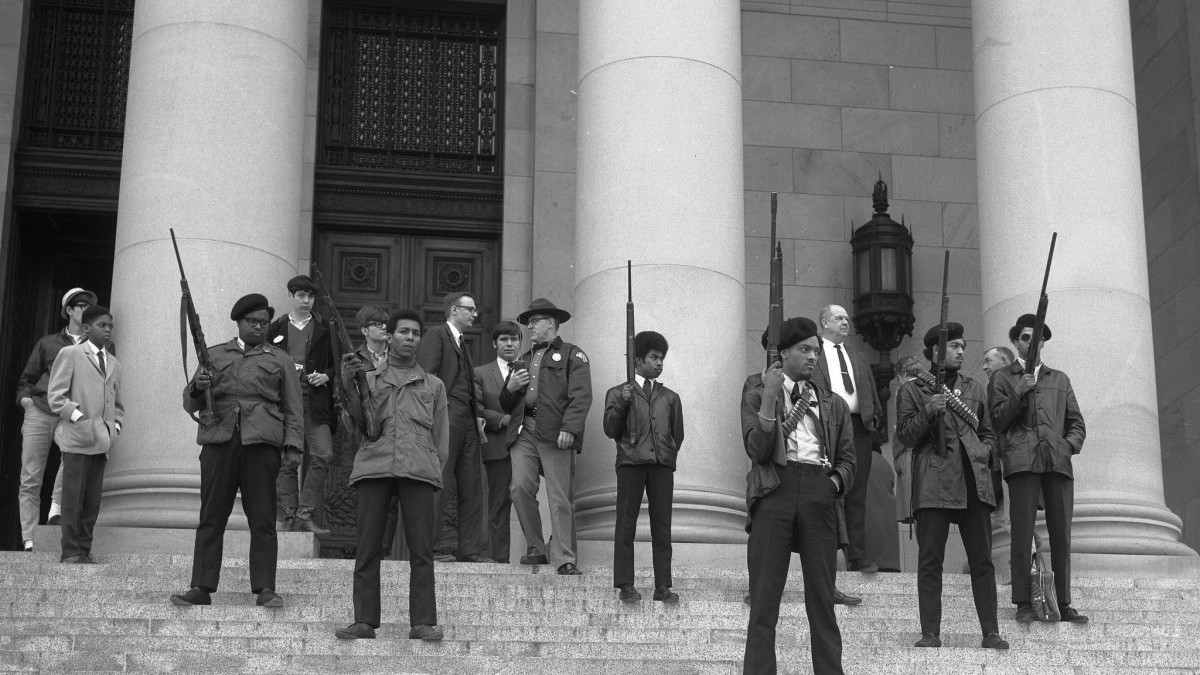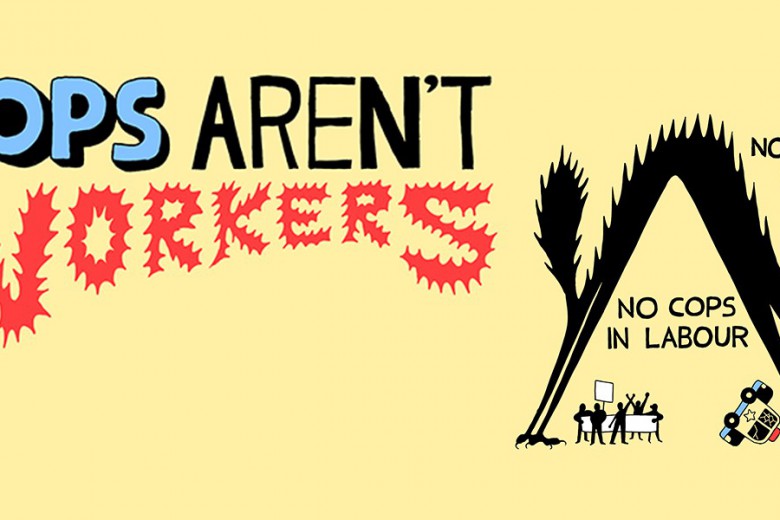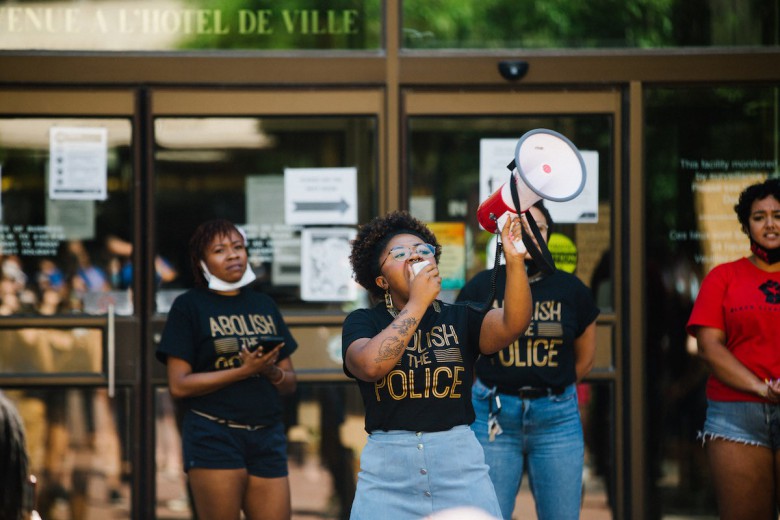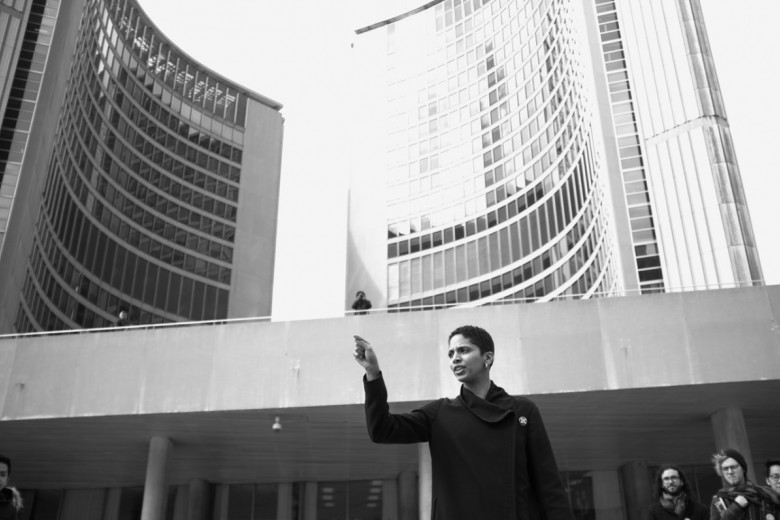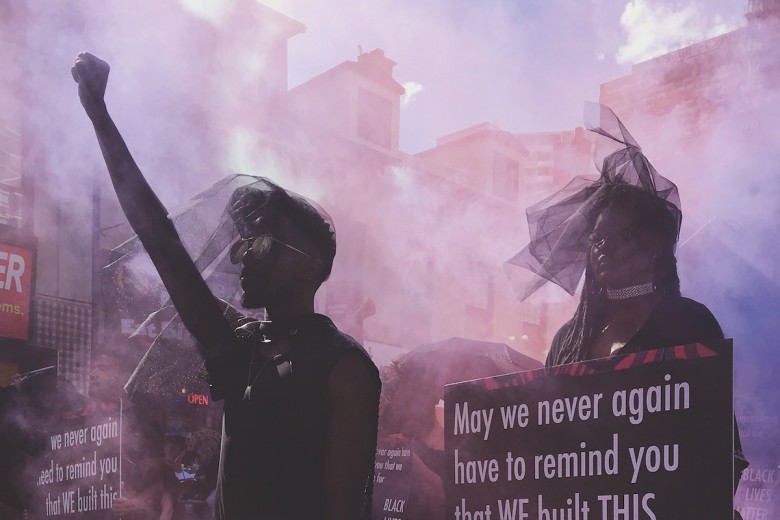When talking about gun culture or gun violence, people are quick to differentiate Canada from the United States, pointing to Canada’s much stricter firearms legislation. But despite our laws, gun violence still happens here. It was not that long ago when we collectively mourned the Quebec City mosque shooting in 2017, and last month’s tragic mass shooting in Nova Scotia—the most lethal in Canada’s history—was reason enough for many to support the Liberal government’s ban on 1,500 types of “assault-style” firearms.
When Trudeau says he’s banning “military-grade” guns, the implication is clear: ordinary people shouldn’t be allowed to have the same weapons as the Canadian military.
But when you factor in the long history of Black people, Indigenous people, and people of colour (BIPOC) using guns to defend their communities against police, the military, and white supremacists, the ban becomes a little more complicated. Coincidently, the news of the ban broke a day before the 53rd anniversary of the Black Panther Party’s march on the California State Capitol. In 1967, 30 Black Panther members armed with rifles and shotguns marched onto the steps of the statehouse in protest of the Mulford Act, a bill aimed at stripping them of their right to bear arms in self-defence against the police brutality they faced at the hands of the racist Oakland Police Department.
The Black Panthers were founded in 1966, following the assassination of Malcolm X and the police killing of an unarmed Black teen named Matthew Johnson. Among other initiatives, the Panthers’ agenda included openly carrying guns, in compliance with California law, to patrol their communities and protect residents against police brutality, “effectively policing the police.”
Following the 1967 protest, and backed by the National Rifle Association (NRA), then-governor Ronald Reagan signed the Mulford Act into law. While he officially cited protecting citizens from gun violence as its justification, it was obvious that the government was trying to stop the Panthers’ armed cop-watching.
Gun legislation is not simply about protecting citizens from gun violence, as politicians would lead us to believe.
To this day, California remains one of the only states that has such strict gun control. Surprisingly, the NRA still supports these restrictions, despite its track record of vehemently (sometimes deceitfully) defending the right to bear arms. So why would a lobby group dedicated to eliminating government regulation of the second amendment, actively support gun legislation in California? It’s because gun legislation is not simply about protecting citizens from gun violence, as politicians would lead us to believe. Rather, as the Mulford Act reveals, gun restrictions are also about disarming the working class—particularly Black and brown people—in order to prevent them from resisting the violence of the state, while keeping guns in the hands of the police and military.
What can we make of the Liberal government’s ban of assault-style firearms in light of this history? Despite key differences between the two countries, the events of 1967 carry important lessons for gun legislation in Canada in 2020—namely that current gun legislation must be understood amid a history and continued presence of state-sanctioned violence.
Whose hands are the “right hands”?
The discussion on gun legislation often hinges on keeping guns in the “right hands.” But whose hands are the “right hands”? Who gets to determine who the “right hands” are?
German sociologist Max Weber famously defined the state as that entity that monopolizes the legitimate use of violence within a given territory. In other words, only the state is allowed to engage in violence both within its own borders, and abroad on behalf of the nation. When other groups engage in violence, regardless of the reason, it is typically deemed illegitimate, and the state uses its penal institutions to admonish them. The only exception to this norm is when white people (almost always men) take up arms and engage in gun violence; historically they have been met with fewer or no repercussions or, like in the case of Bernhard Goetz, have been painted as heroes or vigilantes. So, when people advocate for gun legislation by arguing that guns should be restricted only to the “right hands,” they take for granted that the state has a right to be armed.
But what does this mean when the state is founded on white supremacy, settler colonialism, heteronormative patriarchy, and class-based exploitation?
In other words, only the state is allowed to engage in violence both within its own borders, and abroad on behalf of the nation.
When Trudeau says he’s banning “military-grade” guns, the implication is clear: ordinary people shouldn’t be allowed to have the same weapons as the Canadian military. As Trudeau says, “these weapons were designed for one purpose, and one purpose only: to kill the largest number of people in the shortest amount of time.” This framing implies that the Canadian military uses automatic and semi-automatic guns to kill people responsibly and accountably.
However, the Canadian military is driven by the logic of imperialism, which thrusts it into lethal exploits abroad. Imperialism consists of global relations of domination and subordination, in which countries of the “Global North systemically drain the wealth and resources of the South, via political, economic, and military means.” Canada’s military is primarily used to back American empire and protect the investments of Canadian multinational corporations abroad: from supporting the U.S. in its various invasions, occupations, and proxy wars in Afghanistan, Iraq, Libya, and Syria; to seizing control of mines and murdering dissenting unionists in Guatemala, Indonesia and more; to overthrowing the anti-imperialist leader of Haiti in a coup d'état.
looting target is unamerican. the real american thing to do is loot iraq iran kuwait pakistan yemen somalia syria afghanistan sudan vietnam mexico cuba panama haiti nicaragua jamaica north korea guatemala the philippines dominican republic guyana chile cambodia angola el salvador
— giabuchi (@jaboukie) May 28, 2020
Similarly, Trudeau’s efforts to disarm civilians (which many feel unfairly targets law-abiding gunowners) precludes addressing and curbing police use of firearms, despite the long history of state-sanctioned police violence and extrajudicial killings of BIPOC, working-class, and disabled people. The genealogy of policing in North America – the arm of the state that carries out its violence at home – can be traced back to the late nineteenth century when the ruling classes needed to protect the newly formed and fragile system of wage-labour capitalism from dissatisfied working classes. Police forces can also trace their origins to slave patrols in the southern U.S., which consisted of white men deputizing themselves to track down and return runaway slaves to their owners. In Canada, the North-West Mounted Police (which would later become the RCMP) was created to “assert sovereignty over Indigenous peoples and their lands” by uprooting them and forcing them onto reserves.
Police institutions have also been used to aggressively and maliciously crush popular workers’ movements to protect property and profits. Anti-union violence is commonplace in Canadian history, as police have often been deployed on behalf of the state and corporations to break up strikes and force workers back to their jobs. In the case of the 1919 Winnipeg General Strike, police used extreme violence to break up protests and killed two unionists. Similarly, during the 1931 Black Tuesday Riots in Saskatchewan, the RCMP unlawfully arrested strikers and fired at unarmed protestors, which resulted in the deaths of three people. In both cases, policing has aimed at “forcefully limiting any possibilities the able-bodied poor may try to pursue to avoid the worst forms of wage labour.”
This state-sanctioned violence is a continued reality for BIPOC, working class folks, women, and 2SLGBTQ+ communities. In late 2019, when the Wet’suwet’en Hereditary Chiefs refused to consent to the Coastal GasLink pipeline’s unlawful construction across their unceded lands, the RCMP, acting on behalf of both the state and the corporation, mounted an aggressive assault on Wet’suwet’en land defenders and allies. It is important to note that the RCMP stormed their territory equipped with military-grade weaponry, under orders to shoot to kill if necessary, while Indigenous land defenders were unarmed.
Rather than addressing structural issues like poverty and intergenerational trauma, which push marginalized communities towards crime, the Prison Industrial Complex uses detention, surveillance, policing, and incarceration to remove them from the sight of white, wealthy society. A study conducted on police brutality in Canada found that between 2000 to 2017, there had been at least 460 deaths attributed to police violence, though only three murder charges were laid against police officers. Black people, who make up only 3.4 per cent of the population, consisted of 9 per cent of these fatalities. Indigenous people, who make up 4.8 per cent of the population, constituted 15.2 per cent of those killed. An Ontario Human Rights Commission (ORHC) report from 2018 found that Black people were nearly 20 times more likely than a white person to be involved in a fatal shooting by the Toronto Police and that while Black people represented just 8.8 per cent of Toronto’s population, they made up nearly “30% of police use-of-force cases that resulted in serious injury or death, 60% of deadly encounters with Toronto Police, and 70% of fatal police shootings.”
In both cases, policing has aimed at “forcefully limiting any possibilities the able-bodied poor may try to pursue to avoid the worst forms of wage labour.”
The National Inquiry into Missing and Murdered Indigenous Women and Girls “[declared] their experience in this country as genocide.” This is evidenced by the fact that Indigenous women constitute 38 per cent of all women in Canadian prisons, despite making up less than 5 per cent of the population, and 50 per cent of inmates sent to solitary confinement are Indigenous women.
These events and statistics demonstrate with disturbing clarity that modern-day policing has not distanced itself from its origins. Since the state has exclusive control over violence, it can engage in violence against its citizens, but the citizens cannot use violence in self-defence. They also can’t turn to a fair and impartial justice system. Cut from the same cloth as the police and military, the justice system is structured to protect police officers from being held accountable. The persistence of state-sanctioned violence means that we cannot rely on the police and the military for protection, because it is their job to uphold and maintain the conditions that produce socioeconomic inequalities. Acknowledging this fact is necessary for the survival of all those at the receiving end of state violence.
A neoliberal solution to gun violence
From the case of the Panthers, we learn that not everybody has the right to bear arms, and that the state believes weaponry should stay within its exclusive domain. Similarly, the history of policing in Canada shows that the state has a vested interest in making sure that marginalized communities remain unarmed. While the intent of this new ban is to confront gun violence head-on, the reality is that the edifice of gun legislation takes power out of the hands of the marginalized peoples, and instead monopolizes it in the hands of the capitalist class and the state that serves them, which relies on racist, sexist, homophobic, imperialistic, and classist violence to sustain the status quo.
At the mercy of the state, military, and police in capitalist societies, BIPOC continue to face violence, but never passively. Everywhere, they take up arms to protect themselves and their communities and resist their oppression. Take, for example, the Kurdish freedom fighters’ all-women YPG Women’s Defense Unit, the Zapatistas’ Army of National Liberation, anarchists in New Orleans in the aftermath of Hurricane Katrina, and Denver’s Brothers Against Racist Cops group.
We do not advocate for everyone and anyone to have access to guns. White supremacists, domestic abusers, and serial killers, for example, should not be armed. In fact, anyone who does not have adequate and exhaustive training should not be using guns. Nor do we support expanding the military industrial complex by enriching weapons manufacturers. In an article for Vox, Kim Kelly outlines what an equitable and safe defence model could look like: community patrols consisting of trusted and well-trained individuals, where those who are armed are democratically chosen by the community and held accountable to them.
While the intent of this new ban is to confront gun violence head-on, the reality is that the edifice of gun legislation takes power out of the hands of the marginalized peoples, and instead monopolizes it in the hands of the capitalist class and the state that serves them
This particular gun regulation bill passed by the Liberal government doesn’t acknowledge the harm inflicted by the police and the military, nor does it deal with its root causes: state-protected structural inequalities. If the aim was to resolve gun violence, the law would tackle police brutality, among other things, head-on. But this law does not disarm the police or military, despite their function as mechanisms of racialized-gendered-class control. Instead, the Canadian state chooses to expand these institutions; for example, the military’s budget for 2019-2020 was increased to $21.9 billion, making the Department of National Defence the federal department with the largest budget.
Turning again to the Nova Scotia shooting: of the 22 people the gunman killed, 13 of them were women. His psychological autopsy uncovers that he was a “woman-hater” with a history of domestic abuse. Professor Robyn Bourgeois pointed out that all of the accused perpetrators of mass murders in Canada have been men, and most of them are white. She urges us to consider mass shootings in relation to patriarchy and white supremacy in Canada.
The Nova Scotia gunman was also noted for his “obsession for policing”; his high school yearbook read that he hoped to be an RCMP officer. On the day of the shooting he impersonated an RCMP officer. He knew that as a white man in an RCMP uniform and cruiser, he would be able to move with a certain level of impunity to enact his violence.
The details of the Nova Scotia shooting reveal how white supremacy and the patriarchy are endemic to the institution of policing, yet this is not reflected or acknowledged in recent gun legislation. Given the speed with which this law was passed (only two weeks after the Nova Scotia shooting) it is fair to speculate that this law is an attempted quick fix for the issue of gun violence. However, banning guns without also having a comprehensive plan to address the root causes of violence leaves much to be desired, not least because access to weaponry will continue to exist, regardless of its legality.
Instead of investing in a thorough plan to deal with the structural issues underlying gun violence in Canada, the federal and provincial governments affirm their commitment to neoliberal principles of privatization and austerity, including the gutting of social welfare services like health and education. The destruction of the social safety net further exacerbates inequality and discrimination and makes marginalized groups more vulnerable to violence. This violence begets more violence.
We should be wary of any state measures that seek to prevent the masses from arming without a commensurate disarmament of the police. When the right to bear arms is monopolized by the state, not only does it give the state carte blanche to engage in violence against BIPOC both at home and abroad, but it also limits their recourse to justice and self-defence. Future discussions and laws that seek to manage gun violence must entail a deeper understanding of the nexus between structural police/military violence, systemic inequalities, and state power.


